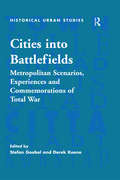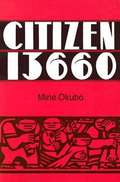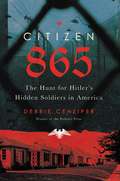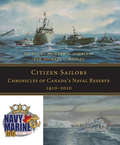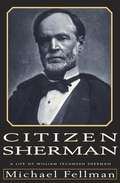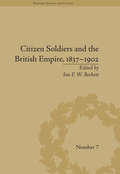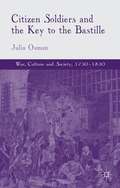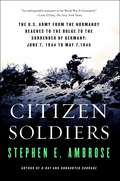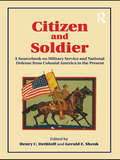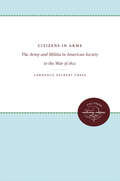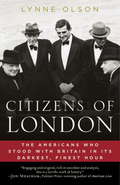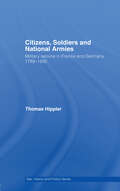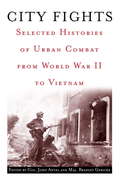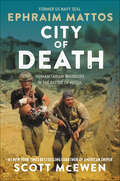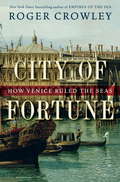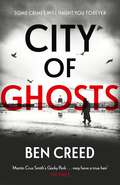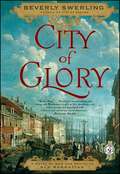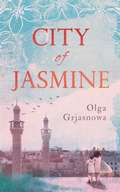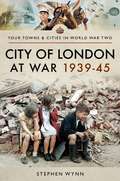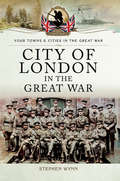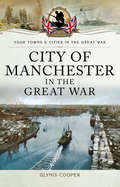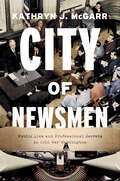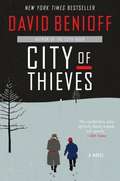- Table View
- List View
Cities into Battlefields: Metropolitan Scenarios, Experiences and Commemorations of Total War (Historical Urban Studies Series)
by Stefan GoebelCities have always had a key role in warfare, as strategic centres which periodically suffered the horrors of siege and sack. With industrialisation, however, they were drawn ever closer to the front line and to direct and continuous experience of fighting and destruction. 'Cities into Battlefields: Metropolitan Scenarios, Experiences and Commemorations of Total War' explores the cultural imprint of military conflict on metropolises world wide in the era of the First and Second World Wars. It brings together cultural and urban historians and scholars of related disciplines including anthropology, education, and geography. The volume examines how the emergence of 'total' warfare blurred the boundaries between home and front and transformed cities into battlefields. The logic of total mobilisation turned the social and cultural fabric of urban life upside down. Arranged so as to bring out the evolution of experience over time, the essays explore Eastern and Central Europe, Britain and Western Europe, and Japan and address several key themes. The first strand - scenarios - explores the apocalyptic imagination of intellectuals and experts in peacetime. Artists and writers anticipating doom presented the coming upheaval as an urban event - a commonplace of late-Victorian and post-1918 pessimism. On a different plane, civil servants and engineers materialised visions of urban chaos and devised countermeasures in case of emergencies. Both groups helped to furnish a repertoire of cultural forms which channelled and encoded the actual experience of war. The second strand deals with metropolitan experiences, notably mobilisation, deprivation, and destruction in wartime. Ruins and the repercussions of war is the central theme of the third strand - commemorations - which investigates post-war efforts to remember and forget. The quest for meaningful forms of commemoration was hard enough after the First World War; the Second World War, which saw whole cities disappear in flames, raised the possibility that the limits of representation had been reached. The central contention of this volume - that total war in the twentieth century has a significant but often overlooked metropolitan dimension - is fully addressed, thereby filling a conspicuous gap in the currently available literature.
Citizen 13660
by Mine OkuboMine Okubo was one of 110,000 People of Japanese descent--nearly two-thirds of them American citizens--who were rounded up into "protective custody" shortly after Pearl Harbor. This poignantly written... memoir of her life in two relocation centers was first published in 1946 and is now reissued with a new Preface by the author.
Citizen 865: The Hunt for Hitler's Hidden Soldiers in America
by Debbie CenziperThe gripping story of a team of Nazi hunters at the U.S. Department of Justice as they raced against time to expose members of a brutal SS killing force who disappeared in America after World War Two.In 1990, in a drafty basement archive in Prague, two American historians made a startling discovery: a Nazi roster from 1945 that no Western investigator had ever seen. The long-forgotten document, containing more than 700 names, helped unravel the details behind the most lethal killing operation in World War Two. In the tiny Polish village of Trawniki, the SS set up a school for mass murder and then recruited a roving army of foot soldiers, 5,000 men strong, to help annihilate the Jewish population of occupied Poland. After the war, some of these men vanished, making their way to the U.S. and blending into communities across America. Though they participated in some of the most unspeakable crimes of the Holocaust, "Trawniki Men" spent years hiding in plain sight, their terrible secrets intact.In a story spanning seven decades, Citizen 865 chronicles the harrowing wartime journeys of two Jewish orphans from occupied Poland who outran the men of Trawniki and settled in the United States, only to learn that some of their one-time captors had followed. A tenacious team of prosecutors and historians pursued these men and, up against the forces of time and political opposition, battled to the present day to remove them from U.S. soil. Through insider accounts and research in four countries, this urgent and powerful narrative provides a front row seat to the dramatic turn of events that allowed a small group of American Nazi hunters to hold murderous men accountable for their crimes decades after the war's end.
Citizen Sailors: Chronicles of Canada's Naval Reserve, 1910-2010
by Richard H. Gimblett Michael L. HadleyThis commemorative volume produced on the occasion of the centennial of the Canadian Navy, 1910-2010, records a special kind of dual citizenship: Canadians exercising the profession of the sea in their nation's service, while also living out the demands of their civilian occupations in their home communities. The perspectives of the part-time citizen-sailors who have made up Canada's Naval Reserve over the past century provide an interesting, valuable, and timely alternative history of the Canadian Navy. Most of the contributors to this volume have served in Canada's Naval Reserve, and all are respected authorities in their fields. Whether read on its own, or as the intended companion to The Naval Service of Canada, 1910-2010: The Centennial Story, readers will find much to delight and inform in this lavish combination of text, photos, and illustrations of the people, ships, and aircraft that have formed a proud national institution.
Citizen Sherman: A Life of William Tecumseh Sherman
by Michael FellmanBright, compulsively articulate, famous, loved, hated, and deeply troubled, William T. Sherman was perhaps one of the most compelling personalities in American history. This groundbreaking, in-depth portrait of this significant Civil War figure reveals much about Sherman--and about the concept of manliness in his culture. NOTE: This edition does not include photographs.
Citizen Soldiers and the British Empire, 1837–1902 (Warfare, Society and Culture #7)
by Ian F BeckettThe British amateur military tradition of raising auxiliary forces for home defence long preceded the establishment of a standing army. This was a model that was widely emulated in British colonies. This volume of essays seeks to examine the role of citizen soldiers in Britain and its empire during the Victorian period.
Citizen Soldiers and the Key to the Bastille
by Julia OsmanShowcasing French participation in the Seven Years' War and the American Revolution, this book shows the French army at the heart of revolutionary, social, and cultural change. Osman argues that efforts to transform the French army into a citizen army before 1789 prompted and helped shape the French Revolution.
Citizen Soldiers: The U.S. Army from the Normandy Beaches to the Bulge to the Surrender of Germany June 7, 1944, to May 7, 1945 (Core Ser.)
by Stephen E. AmbroseFrom Stephen E. Ambrose, bestselling author of Band of Brothers and D-Day, the inspiring story of the ordinary men of the U.S. army in northwest Europe from the day after D-Day until the end of the bitterest days of World War II.In this riveting account, historian Stephen E. Ambrose continues where he left off in his #1 bestseller D-Day. Citizen Soldiers opens at 0001 hours, June 7, 1944, on the Normandy beaches, and ends at 0245 hours, May 7, 1945, with the allied victory. It is biography of the US Army in the European Theater of Operations, and Ambrose again follows the individual characters of this noble, brutal, and tragic war. From the high command down to the ordinary soldier, Ambrose draws on hundreds of interviews to re-create the war experience with startling clarity and immediacy. From the hedgerows of Normandy to the overrunning of Germany, Ambrose tells the real story of World War II from the perspective of the men and women who fought it.
Citizen and Soldier: A Sourcebook on Military Service and National Defense from Colonial America to the Present
by Henry C. Dethloff Gerald E. ShenkAmericans grow up expecting that in a time of need, their country can depend on its people for volunteer service to the military. Indeed, this has been a social and at times legal expectation for the citizenship of this country since 1776. Yet, since the end of World War II United States forces have been caught up in many long term military engagements, and the military aspect of citizenship has become an increasingly marginalized one in a world where only a minority of citizens even vote. Citizen and Soldier: A Sourcebook on Military Service and National Defense from Colonial America to the Present provides a useful framework and supporting documentary evidence for an informed discussion of the development of the American ideal of the "Citizen Soldier". Presented with insightful introductions and useful discussion questions, this concise collection of 27 primary documents takes a close look at the United States military and shows how it became entwined with the rise of American national identity.
Citizens in Arms: The Army and Militia in American Society to the War of 1812
by Lawrence Delbert CressThis first study to discuss the important ideological role of the military in the early political life of the nation examines the relationship between revolutionary doctrine and the practical considerations of military planning before and after the American Revolution. Americans wanted and effective army, but they realized that by its very nature the military could destroy freedom as well as preserve it. The security of the new nation was not in dispute but the nature of republicanism itself.Originally published 1982. A UNC Press Enduring Edition -- UNC Press Enduring Editions use the latest in digital technology to make available again books from our distinguished backlist that were previously out of print. These editions are published unaltered from the original, and are presented in affordable paperback formats, bringing readers both historical and cultural value.
Citizens of London: How Britain Was Resuced in Its Darkest, Finest Hour
by Lynne OlsonThe acclaimed author of Troublesome Young Men reveals the behind-the-scenes story of how the United States forged its wartime alliance with Britain, told from the perspective of three key American players in London: Edward R. Murrow, the handsome, chain-smoking head of CBS News in Europe; Averell Harriman, the hard-driving millionaire who ran FDR's Lend-Lease program in London; and John Gilbert Winant, the shy, idealistic U.S. ambassador to Britain. Each man formed close ties with Winston Churchill--so much so that all became romantically involved with members of the prime minister's family. Drawing from a variety of primary sources, Lynne Olson skillfully depicts the dramatic personal journeys of these men who, determined to save Britain from Hitler, helped convince a cautious Franklin Roosevelt and reluctant American public to back the British at a critical time. Deeply human, brilliantly researched, and beautifully written, Citizens of London is a new triumph from an author swiftly becoming one of the finest in her field.he Blitz into a model of stoic grace under violent pressure and deprivation. Deeply human, brilliantly researched, and beautifully written, Citizens of London is a new triumph from an author swiftly becoming one of the finest in her field.
Citizens, Soldiers and National Armies: Military Service in France and Germany, 1789–1830 (War, History and Politics)
by Thomas HipplerThis book examines the creation of ‘national armies’ through compulsory military service in France and Prussia during the French Revolution and the Prussian Reform Period. The French Revolution tried to establish military and political structures in which the armed forces and society would merge. In order to ensure that the army would never become a means of oppression against the people, the whole population should thus ‘be’ the army. Defeated by the enormous military potential that these new political settings had unchained in France, Prussia adapted the French innovations to its own needs, thus laying the basis for its contributions to the victories of the coalition troops in 1813-15. Conscription had implications that went beyond the purely military sphere and involved assumptions about the nature of the state and its relationship to its citizens. It was the material basis of Napoleon’s campaigns and of the German ‘wars of national liberation’ of 1813-15, before becoming a cornerstone of the Prussian Reforms and the creation of a civil society ‘from above’. Military service has therefore been one of the most essential and contradictory institutions of the modern nation-state. Citizens, Soldiers and National Armies will be of interest to historians of modern Europe, military historians and students of intellectual history in general.
Citizenship in Action and Leadership: Theory and Application
by United State Army Junior ROTCThe book introduces lessons to the learners about the US Army Junior Reserve Officers' Training Corps (JROTC) Program, its mission, and the Leadership Education and Training (LET) curriculum for the first level of their instructions.
City Fights: Selected Histories of Urban Combat from World War II to Vietnam
by John Antal Bradley GerickeEdited by Colonel John Antal and Maj. Bradley Gericke, urban terrain will likely be the predominant battlefield of future wars. As September 11 and Somalia proved, hostile forces are now engaging America differently, avoiding open combat with our enormous military, striking at our civic centers or dragging us into theirs. But urban warfare isn't new; it is as old as the battle of Jericho. Now an incomparable collection written by esteemed military veterans--some currently serving, others civilian analysts--re-creates the last century's most astonishing examples of this kind of fighting . . . and offers important lessons for our future. Here are fourteen riveting histories that are both invaluable teaching tools for security leaders and engrossing accounts for any reader. They include* William M. Waddell's "Tai-Erh-Chuang, 1938: The Japanese Juggernaut Smashed"--How China defeated the Japanese in battle for the first time in three hundred and forty years, by using a city only as a pivot area and attacking the exposed flank and rear ranks of its unprepared enemy.* Eric M. Walters's "Stalingrad, 1942: With Will, a Weapon, and a Watch"--The largest and longest-running urban fight of the twentieth century, in which the Red Army became the tortoise to the Germans' hare, out-lasting its stronger foe.* Norm Cooling's "Hue City, 1968: Winning a Battle While Losing a War"--The six-day fight for the cultural center of Vietnam revealed how the American military's distrust of the media made it fail to expose the enemy's mass executions and lose the all-important information war.From the 1944 Warsaw uprising that almost caused the complete destruction of Poland's capital to the crucial, near-forgotten fight for Manila in 1945 . . . from snipers and shoulder-launched missiles to tunnels and tanks . . . all aspects of the most important urban conflicts are revealed in stunning detail. Compelling and cautionary, City Fights powerfully reminds us that, in our ever more urbanized and vulnerable world, "if a state loses its cities, it loses the war."
City of Death: Humanitarian Warriors in the Battle of Mosul
by Scott McEwen Ephraim MattosA frontline witness account of the deadly urban combat of the Battle of Mosul told by former Navy SEAL and frontline combat medic Ephraim Mattos.After leaving the US Navy SEAL teams in spring of 2017, Ephraim Mattos, age twenty-four, flew to Iraq to join a small group of volunteer humanitarians known as the Free Burma Rangers, who were working on the frontlines of the war on ISIS.Until being shot by ISIS on a suicidal rescue mission, Mattos witnessed unexplainable acts of courage and sacrifice by the Free Burma Rangers, who, while under heavy machine gun and mortar fire, assaulted across ISIS minefields, used themselves as human shields, and sprinted down ISIS-infested streets-all to retrieve wounded civilians.In City of Death: Humanitarian Warriors in the Battle of Mosul, Mattos recounts in vivid detail what he saw and felt while he and the other Free Burma Rangers evacuated the wounded, conducted rescue missions, and at times fought shoulder-to-shoulder with the Iraqi Army against ISIS. Filled with raw and emotional descriptions of what it's like to come face-to-face with death, this is the harrowing and uplifting true story of a small group of men who risked everything to save the lives of the Iraqi people and who followed the credence, "Greater love hath no man than this, that a man lay down his life for his friends."As the coauthor of the #1 New York Times bestselling American Sniper, Scott McEwen has teamed up with Mattos to help share an unforgettable tale of an American warrior turned humanitarian forced to fight his way into and out of a Hell on Earth created by ISIS.
City of Fortune: How Venice Ruled the Seas
by Roger CrowleyThe rise and fall of the Venetian empire stands unrivaled for drama, intrigue, and sheer opulent majesty. In City of Fortune, Roger Crowley, acclaimed historian and New York Times bestselling author of Empires of the Sea, applies his narrative skill to chronicling the astounding five-hundred-year voyage of Venice to the pinnacle of power. Tracing the full arc of the Venetian imperial saga for the first time, City of Fortune is framed around two of the great collisions of world history: the ill-fated Fourth Crusade, which culminated in the sacking of Constantinople and the carve-up of the Byzantine Empire in 1204, and the Ottoman-Venetian War of 1499-1503, which saw the Ottoman Turks supplant the Venetians as the preeminent naval power in the Mediterranean. In between were three centuries of Venetian maritime dominance--years of plunder and plague, conquest and piracy--during which a tiny city of "lagoon dwellers" grew into the richest place on earth. Drawing on firsthand accounts of pitched sea battles, skillful negotiations, and diplomatic maneuvers, Crowley paints a vivid picture of this avaricious, enterprising people and the bountiful lands that came under their dominion. Defiant of emperors, indifferent to popes, the Venetians saw themselves as reluctant freebooters, compelled to take to the open seas "because we cannot live otherwise and know not how except by trade." From the opening of the spice routes to the clash between Christianity and Islam, Venice played a leading role in the defining conflicts of its time--the reverberations of which are still being felt today. Only an author with Roger Crowley's deep knowledge of post-Crusade history could put these iconic events into their proper context. Epic in scope, magisterial in its understanding of the period, City of Fortune is narrative history at its most engrossing.From the Hardcover edition.
City of Ghosts: A Times 'Thriller of the Year' (A\revol Rossel Thriller Ser.)
by Ben Creed'Reminded me of Gorky Park, only I liked this tense, complex thriller even better' JAMES PATTERSON *Shortlisted for the 2021 CWA Gold Dagger and the John Creasey 'New Blood' Dagger* 'Brilliantly orchestrated and totally engrossing' THE CRIME WRITERS' ASSOCIATION ______Leningrad, Russia, 1951.The shadow of war lingers. Revol Rossel – once a virtuoso violinist with a glittering future – is now a humble state militia cop, forced to investigate desperate crimes in this desperate era.But when five frozen corpses are found neatly arranged between railway lines, Rossel is faced with the most puzzling – and most dangerous – case of his career. His hunt for the truth leads him to the dark heart of Leningrad's musical establishment, and, ultimately, to the highest levels of the Kremlin itself.It's a world he knows intimately. A world where his dreams were shattered.A world where a killer may now be hiding...'A highly assured and entertaining debut . . . Martin Cruz Smith's Gorky Park [...] may have a true heir' THE TIMES'A worthy successor to Cruz Smith's Arkady Renko . . . A fine and often moving thriller' FINANCIAL TIMES'Gripping . . . with historical heft, plenty of twists along the way, and a uniquely ingenious code left behind by our murderer. An excellent start to a new historical crime series' VASEEM KHAN
City of Glory: A Novel of War and Desire in Old Manhattan (City #2)
by Beverly SwerlingSet against the dramatic backdrop of America’s during the War of 1812, Beverly Swerling’s gripping and intricately plotted sequel to the much-loved City of Dreams plunges deep into the crowded streets of old New York.Poised between the Manhattan woods and the sea that is her gateway to the world, the city of 1812 is vibrant but raw, a cauldron where the French accents of Creole pirates mingle with the brogues of Irish seamen, and shipments of rare teas and silks from Canton are sold at raucous Pearl Street auctions. Allegiances are more changeable than the tides, love and lust often indistinguishable, the bonds of country weak compared to the temptation of fabulous riches from the East, and only a few farseeing patriots recognize the need not only to protect the city from the redcoats, but to preserve the fragile Constitutional union forged in 1787. Joyful Patrick Turner, dashing war hero and brilliant surgeon, loses his hand to a British shell, retreats to private life, and hopes to make his fortune in the China trade. To succeed he must run the British blockade; if he fails, he will lose not only a livelihood, but the beautiful Manon, daughter of a Huguenot jeweler who will not accept a pauper as a son-in-law. When stories of a lost treasure and a mysterious diamond draw him into a treacherous maze of deceit and double-cross, and the British set Washington ablaze, Joyful realizes that more than his personal future is at stake. His adversary, Gornt Blakeman, has a lust for power that will not be sated until he claims Joyful’s fiancée as his wife and half a nation as his personal fiefdom. Like the Turners before him, Joyful must choose: his dreams or his country. Swerling’s vividly drawn characters illuminate every aspect of the teeming metropolis: John Jacob Astor, the wealthiest man in America, brings the city’s first Chinese to staff his palatial Broadway mansion; Lucretia Carter, wife of a respectable craftsman, makes ends meet as an abortionist serving New York’s brothels; Thumbless Wu, a mysterious Cantonese stowaway, slinks about on a secret mission; and the bewitching Delight Higgins, proprietress of the town’s finest gambling club, lives in terror of the blackbirding gangs who prey on runaway slaves. They are all here, the butchers and shipwrights, the doctors and scriv-eners, the slum dwellers of Five Points and the money men of the infant stock exchange...conspiring by day and carousing by night, while the women must hide their loyalties and ambitions, their very wills, behind pretty sighs and silken skirts.
City of Jasmine
by Olga GrjasnowaSyria - a country at war Amal, Hammoudi and Youssef are young and ambitious, the face of modern Syria. But when civil war tears through their homeland, they are left with a horrifying choice: risk death by staying in the country they love, or flee in search of a new life elsewhere? From one of Germany's most talented literary voices comes this intricately woven story of brutality, loss, and how hope can shine through when darkness feels overwhelming.
City of London at War 1939–45 (Towns & Cities in World War Two)
by Stephen WynnA photo-filled history of how London’s historic business district endured the Blitz during World War II, and emerged to thrive once again.The City of London was an obvious target for German bombers during the Second World War. What better way for Nazi Germany to spread fear and panic amongst the British people than by attacking their central business district? Although it wasn’t densely populated, there were still enough people working there during the day for attacks on it to take their toll. The city’s ancient and iconic buildings also bore the brunt of the German bombs, including churches designed by Sir Christopher Wren after the Great Fire in 1666.The book looks at the effects of war on the City of London, including the damage caused by the eight months of the Blitz between September 1940 and May 1941. The most devastating of the raids took place on December 29, 1940, with both incendiary and explosive bombs causing a firestorm so intense it was known as the Second Great Fire of London.It also looks at the bravery of the staff at St Bart’s Hospital, which was one of the medical facilities that remained open during the course of the war. Other stories include the sterling work carried out by the City’s civilian population and the voluntary roles that they performed to help keep the city safe, including the Home Guard and the Fire Watchers, who spent their nights on the city’s rooftops looking out for incendiary devices dropped by the Luftwaffe. Ultimately, despite the damage to its buildings and population, by the end of the war the City of London was able to rise, like a phoenix, from the flames of destruction, ready to become the vibrant and flourishing borough that it is today.
City of London in the Great War (Your Towns & Cities in the Great War)
by Stephen WynnThroughout the First World War, London played a major part in Great Britain's war effort, both at home and abroad. A far as Germany was concerned, the city was their ultimate goal the ultimate target that would bring them the sought-after victory they so desired. With the British Royal Family at Buckingham Palace, the heart of British Government at the Houses of Parliament and one of Europe's major financial centres, situated at the Bank of England, London was a major prize that would either be protected or lost to the enemy. With a real belief amongst the British public that there would be an invasion at some time during the war, the security of the countries capital was paramount not only for survival of the nation, but also to ensure that public morale remained high.The capital was a central hub for recruitment with centres popping up all over the city, at places such as Scotland Yard and the Tower of London. There was a regiment for everybody, catering for all elements of society from the labourer, to the landed gentry, for the more affluent, as well as those less well off, and from the professional sportsman, to the city banker; everybody wanted to do their bit for King and Country.The book looks at many different aspects of wartime London: the Members of Parliament who left their comfortable lifestyles, who fought and died for their country, the Silvertown munitions factory explosion, the twelve German spies who were shot at the Tower of London, and the hundreds of military hospitals that were spread across London. Part of St Thomas's Hospital, for example, treated the wounds of 11,396 military personnel between 1915-19.City of London in the Great War records yet another chapter in the history of the nation's capital, during the four-year period of time, which will live in the memory of the city forever more.
City of Manchester in the Great War (Your Towns & Cities in the Great War)
by Glynis CooperThe war touched almost every aspect of life on the Home Front, and those who were left behind suffered terribly. This book meticulously explores the problems, hardships and grief faced by Manchesters people and takes a detailed look the unfortunate areas that were hit the hardest.Throughout Britain, industry declined and wages suffered; prices of food and fuel rose sharply; essential foodstuffs and coal were hoarded for the black market; soldiers families doubled up with others, which caused severe overcrowding; housing and sanitation improvements ceased; there were epidemics of measles, chicken pox, influenza and TB; German U-boats tried to prevent supplies reaching Britain; and Zeppelin airships attempted to destroy British trade and industry.Manchester City suffered greatly because of its cotton trade, its industrial output, and its proximity to Liverpool, but its citizens were determined not to let the Kaiser win. This book documents how they fought back by living in a twilight world of black outs so that enemy airships would miss their targets; how they accepted emergency rationing of food and coal, and restrictions; and how they worked tirelessly in the nearby cotton mills and munitions factories, and dug for victory on their allotments. Overall, the people of Manchester were united in their grief over the sad loss of life on the fronts. This grief broke across class barriers and saw debutantes and mill girls, alike, take comfort in each other.City of Manchester in the Great War tells the remarkable story of the spirit of a city whose citizens refused to give in, who strived to fight the odds that were stacked against them.
City of Newsmen: Public Lies and Professional Secrets in Cold War Washington
by Kathryn J. McGarrAn inside look at how midcentury DC journalists silenced their own skepticism and shaped public perceptions of the Cold War.“A vivid, deeply researched account that presents the elite political press corps back then in a much more favorable light, as a highly professional group whose members were also highly constrained by the blindnesses that were pervasive in that time, place, and culture.” —Nicholas Lemann, staff writer for The New YorkerAmericans’ current trust in journalists is at a dismayingly low ebb, particularly on the subject of national and international politics. For some, it might be tempting to look back to the mid-twentieth century, when the nation’s press corps was a seemingly venerable and monolithic institution that conveyed the official line from Washington with nary a glint of anti-patriotic cynicism. As Kathryn McGarr’s City of Newsmen shows, however, the real story of what Cold War–era journalists did and how they did it wasn’t exactly the one you’d find in the morning papers.City of Newsmen explores foreign policy journalism in Washington during and after World War II—a time supposedly defined by the press’s blind patriotism and groupthink. McGarr reveals, though, that DC reporters then were deeply cynical about government sources and their motives, but kept their doubts to themselves for professional, social, and ideological reasons. The alliance and rivalries among these reporters constituted a world of debts and loyalties: shared memories of harrowing wartime experiences, shared frustrations with government censorship and information programs, shared antagonisms, and shared mentors. McGarr ventures into the back hallways and private clubs of the 1940s and 1950s to show how white male reporters suppressed their skepticism to build one of the most powerful and enduring constructed realities in recent US history—the Washington Cold War consensus. Though by the 1960s, this set of reporters was seen as unduly complicit with the government—failing to openly critique the decisions and worldviews that led to disasters like the Vietnam War—McGarr shows how self-aware these reporters were as they negotiated for access, prominence, and, yes, the truth—even as they denied those things to their readers.“A riveting account—and an original analysis—of Washington’s midcentury foreign policy press corps, deftly incorporating analyses of gender, race, and religion. . . . McGarr’s skillful portrayals of historical personalities, placed within rich historical contexts, provides a compelling narrative.” —Estelle B. Freedman, author of Redefining Rape: Sexual Violence in the Era of Suffrage and Segregation
City of Sparrows
by Eva NourBased on a true story — the thoughtful, raw, and ultimately heartening tale of a young man fighting for survival in a city under siegeGrowing up in Syria in the 1990s, Sami&’s childhood was unremarkable. His day-to-day life largely sheltered him from the horrors of the authoritarian government, until he founded a successful internet company—which landed him on the regime&’s radar. Suddenly Sami finds himself in jail, then forcibly enlisted into the Syrian army during the early days of a fast-growing civil uprising. Assigned to the mapmaking division, Sami yearns to simply serve his time and go home, even as he finds himself literally charting the course of the army&’s response to the growing revolt. The situation that hits him full-force when he receives a text from his girlfriend: &“They&’re shooting at us.&” With that, Sami realizes that it is not enough to endure Assad's regime -- he has to resist. He has to return home, to the city that will become known as the "capital of the revolution." Based on true events as told to journalist Eva Nour, City of Sparrows is the story of coming of age under siege and the power of hope in the face of unfathomable loss.
City of Thieves
by David BenioffFrom the critically acclaimed author of The 25th Hour, a captivating novel about war, courage, survival, and a remarkable friendship that ripples across a lifetime. During the Nazis' brutal siege of Leningrad, Lev Beniov is arrested for looting and thrown into the same cell as a handsome deserter named Kolya. Instead of being executed, Lev and Kolya are given a shot at saving their own lives by complying with an outrageous directive: secure a dozen eggs for a powerful Soviet colonel to use in his daughter's wedding cake. In a city cut off from all supplies and suffering unbelievable deprivation, Lev and Kolya embark on a hunt through the dire lawlessness of Leningrad and behind enemy lines to find the impossible. By turns insightful and funny, thrilling and terrifying, City of Thieves is a gripping, cinematic World War II adventure and an intimate coming-of-age story with an utterly contemporary feel for how boys become men.
